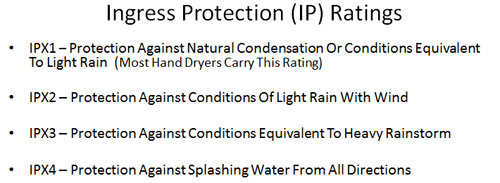Energy-Efficient Hand Dryers
With the above basic information in hand, the architect can also assess some other general restroom needs including the following:
Noise Considerations
People, fixtures, and equipment all make noise. Different building types have different tolerance levels for that noise as it relates to the overall indoor environment. Therefore, the appropriate level of attention should be paid to noise control or reduction based on the needs of the building and the users. Of particular note, the US Green Building Council LEED® rating system has recently identified noise control as a factor for indoor environmental quality, particularly in schools. They have gone so far as to identify noise levels in and between selected rooms, especially between classrooms and adjacent rooms. Therefore, increasing attention is being paid to containing the noise levels within restrooms.
Handicapped Accessibility Compliance
All public and most employee restrooms need to meet handicapped accessibility standards as covered in the Americans with Disabilities Act (ADA) or in building codes that reference ICC-ANSI 117.1. Such compliance extends beyond just paths of travel, turning radii, and grab bars. It also applies to all of the fixtures and equipment located in the restroom that is designated to serve physically handicapped persons. In particular, mounting heights need to be specified and protrusions from the wall need to be limited—or in some cases recessed into the wall. Hence, compliance goes beyond design layouts and extends to specification of equipment as well.
 |
Hands-free or touch-free operation of restroom equipment and fixtures helps assure improved sanitation. Source courtesy of World Dryer, Inc. |
Sanitation
Heightened public awareness of dangerous infections such as MRSA and HlNl has contributed to a heightened scrutiny of restroom hygiene. Because of this, terms such as "hands-free" and "touchless" have become commonplace among building managers and users. The reality is no one wants to touch something where someone else's bacteria-laden hands may have been. Therefore, facilities managers are seeking alternatives such as motion-sensor soap dispensers, automatic faucets and touchless hand dryers that help eliminate the need to touch surfaces. Of course, hand hygiene plays a fundamental role in minimizing the spread of infectious diseases, bacteria, viruses and parasites. Dangerous microorganisms and bacteria harbor on the surface of the skin; however proper hand washing with soap and water, coupled with sanitary hand drying techniques, can dramatically reduce the spread of harmful disease and bacteria-especially in highly public areas such as food preparation facilities, educational institutions, and clinical/medical environments.
Finger and Water Ingress Protection
Any equipment with openings where hands come into contact with it is prone to accidently having fingers etc. get stuck in those openings. Some equipment can also be prone to exposure to water infiltration or ingress not just from normal usage but from washroom cleaning processes and protocols. For example, some facilities routinely wash the floors and walls with a hose and water spray, meaning that anything on the walls is subject to getting hit with that water spray. The National Electrical Manufacturers Association (NEMA) working in conjunction with the International Electrotechnical Commission (IEC) has established standards that address both of these ingress concerns with an Ingress Protection (IP) rating for equipment, particularly for any electrical equipment. The IP rating is a 2 digit number after the letters IP where the first digit rates protection against objects entering the unit and the second rates protection against water ingress (or water entering the unit). So, in the case of restroom equipment, a rating of IP24 for example is desirable. The first digit of “2” means that objects the size of fingers or similar will not fit into openings while the second digit of “4” means that water will not penetrate when sprayed or splashed in any direction. For more information on this topic and the NEMA IP ratings, see: http://www.nema.org/Products/Documents/nema-enclosure-types.pdf. For a summary of the IEC standard adopted by ANSI in this country, see: http://www.nema.org/Standards/ComplimentaryDocuments/ANSI-IEC-60529.pdf
 |
Ingress Protection (IP) Ratings are assigned for differing levels penetration resistance – the second digit of the rating indicates the ability of an electrical product to resist varying levels of water conditions. Source: World Dryer, Inc. |









